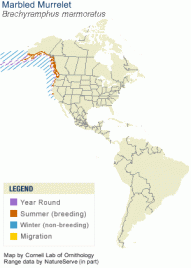Alaska Species Explorer

All
x
- – No known individuals remaining.
- – Known only to survive in captivity, or as a naturalized population outside its historic range.
- – Extremely high risk of extinction in the wild.
- – High risk of extinction in the wild.
- – High risk of endangerment in the wild.
- – Likely to become endangered in the near future.
- – Lowest risk. Does not qualify for a higher risk category. Widespread and abundant taxa are included in this category.
- – Not enough data to make an assessment of its risk of extinction.
- – Has not yet been evaluated against the criteria.
Marbled Murrelet
- – No known individuals remaining.
- – Known only to survive in captivity, or as a naturalized population outside its historic range.
- – Extremely high risk of extinction in the wild.
- – High risk of extinction in the wild.
- – High risk of endangerment in the wild.
- – Likely to become endangered in the near future.
- – Lowest risk. Does not qualify for a higher risk category. Widespread and abundant taxa are included in this category.
- – Not enough data to make an assessment of its risk of extinction.
- – Has not yet been evaluated against the criteria.
Aleutian Islands in Alaska, south to central California. Spring and summer records also exist in Alaska for Bristol Bay, the northern Bering Sea, and St. Lawrence Island. The winter range is not well documented, but known winter concentrations occur in Southeast Alaska, the Kodiak Archipelago, Cook Inlet, Prince William Sound, and some areas of the Gulf of Alaska.
A dramatic decline in the population caused concern throughout its range and the Washington-Oregon-California population was federally listed as Threatened under the Endangered Species Act in 1992. The Canadian population in British Columbia was assigned Threatened status in 1990. In Alaska, the Marbled Murrelet is considered a Bird of Conservation Concern by the U.S. Fish and Wildlife Service
In its breeding plumage, the top of the head, back and wings are dark brown, while the throat, chest and abdomen are brown flecked with white and cinnamon, giving a “marbled” appearance. Males and females have similar coloring. The winter plumage is blackish brown above with largely white shoulders (scapulars) and white under parts.
Breeds in coniferous forests near coasts, nesting on large horizontal branches high up in trees. They spend winters at sea.
- Unlike most seabirds, they do not nest in colonies
- The Marbled Murrelet usually nests in trees greater than 200 years in age.
- The first verified nest discovery was in a tree, in 1974.

















